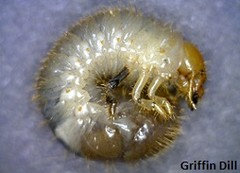Organic solutions for Japanese Beetle control?
bcb77
17 years ago
Featured Answer
Sort by:Oldest
Comments (25)
efam
17 years agorhizo_1 (North AL) zone 7
17 years agoRelated Discussions
What's your best solution for Japanese Beetles?
Comments (21)I second the advise to get guineas. I walk along my grape arbors and call the guineas over, then either knock the beetles off, or gather them up by hand and feed the guineas. They love 'em. I also think that they, and possibly chickens too, eat them as they emerge from the ground after the larval stage. I used to see lots of beetles climbing up tall plants, like ornamental grasses, I think to get in the sun so they can dry and harden and fly off to find our tender plants. I also have heard that traps just attract more beetles. But I've also heard of folks putting the traps inside the poultry run, then dumping the bugs out occasionally for the birds. Or even running a tube from the bottom of the bag to ground level so when the bug falls all the way out, it can get snapped up....See MoreOrganic Elm beetle control?
Comments (1)There are all kinds of organic solutions presented on the internet to control elm beetles. A few of them are pyrethrins, diatomaceous earth, Bacillus thuringiensis v. tenebrionis, and Bacillus thuringiensis v. san diego. I googled "elm beetle organic control" and found all kinds of information. As with most pest solutions, if you can talk your neighbors into working with you in their yards, most of these controls will work much better....See MoreJapanese beetles: too late to kill them off?
Comments (37)Wow! Lot's of great ideas, but most won't work...don't waste your sanity or household funding on traps and chemicals. You have to know the insect's vulnerability and have the willingness to go to town on them a few days a week when they come out to breed...usually in the month of July...the little buggers bee-line straight for anything resembling roses, vining plants and assorted fruiting trees...treating you garden like government cheese. Here's the trick. The Japanese beetle's vulnerabilty is temperature and it's innate tuck & roll defense strategy. When the sun goes down and the temperature drops the beetles do not fly. Simply put your non-dominant hand under the leaf of the plant and then lightly tap the leaf with the other and they will fall directly into your palm...they don't bite, sting or scratch...no worries. You can humanely crush them between your digits or if you're a wimp you can put them in a jar at the end of your raiding mission...cap the jar and let the sun bake them the next day...empty jar of baked beetles in the trash, rinse and repeat the following evening. I guarantee they will get the hint and you can have your garden back....See MoreOrganic Insect Control in the Home Landscape
Comments (2)Hi Dawna, Thanks for the kind words. I just wanted to put together a little info sheet for everyone because the pests are so bad this year, and everyone has had a lot of questions. It sure has been raining a lot up your way. I hope all is well there. At least we aren't having to worry about wildfires or a hay shortage this year. Flooding, however, may be this summer's big issue. Dawn...See Moreanaturelover
17 years agoanaturelover
17 years agobcb77
17 years agorhizo_1 (North AL) zone 7
17 years agomichelle11
17 years agobama35640
17 years agocatbird
17 years agokabby_z8
17 years agorhizo_1 (North AL) zone 7
17 years agooutsideplaying_gw
17 years agogw:saffi-bee
17 years agostarzstuff_yahoo_com
16 years agomahersea_yahoo_com
14 years agoUser
14 years agoscandia
14 years agorhizo_1 (North AL) zone 7
14 years agolily51
13 years agorhizo_1 (North AL) zone 7
13 years agosmithmal
11 years agorhizo_1 (North AL) zone 7
11 years agojessjennings0 zone 10b
8 years agorobertsoncroc
6 years ago
Related Stories

ORGANIZINGOrganizing Secrets: It’s the Little Things
Get these 8 small areas under control for a major boost in overall tidiness at home
Full Story
STORAGE10 Savvy Storage Solutions for Converted Attics
Find a home for all your stuff in the upper reaches of the house
Full Story
ORGANIZINGProfessional Tips for Organizing Your Clothes Closet
As summer draws to a close, get expert advice on editing and organizing your wardrobe
Full Story
GARDENING GUIDESHow to Switch to an Organic Landscape Plan
Ditch the chemicals for a naturally beautiful lawn and garden, using living fertilizers and other nontoxic treatments
Full Story
LIFETop 10 Unsung Organizing Tools
Look no farther than your drawers, closets or purse for the best and cheapest ways to keep your home neat and organized
Full Story
BATHROOM DESIGNGet It Done: Organize the Bathroom for Well-Earned Bliss
You deserve the dreamy serenity of cleared countertops, neatly arranged drawers and streamlined bathroom storage
Full Story
BOOKSCan Tidying Up Result in Life-Changing Magic?
Organizing phenom Marie Kondo promises big results — if you embrace enormous changes and tough choices
Full Story
ORGANIZINGPersonal Spaces: 12 Real-Life Savvy Shoe Storage Ideas
Check out how these homeowners keep their footwear organized — tucked away or out on display
Full Story
ORGANIZINGDecluttering Ideas From Around the World
Home organizers share their tips on how to think and live more clearly
Full Story
DECLUTTERING10 Types of Clutter to Toss Today
Clear the decks and give the heave-ho to these unneeded items
Full StorySponsored




spidercat